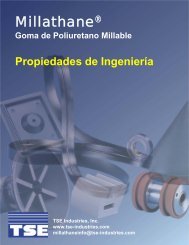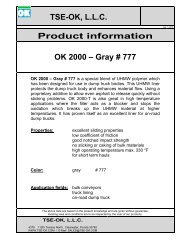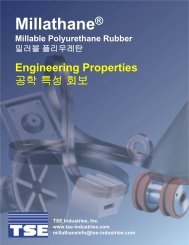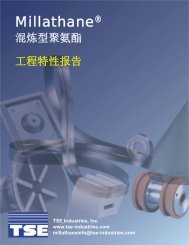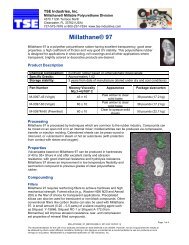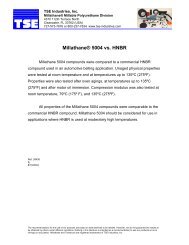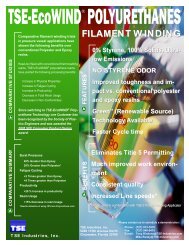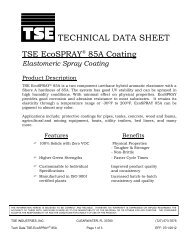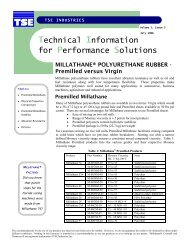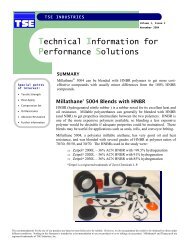Millathane® 76 Datasheet - TSE Industries, Inc.
Millathane® 76 Datasheet - TSE Industries, Inc.
Millathane® 76 Datasheet - TSE Industries, Inc.
You also want an ePaper? Increase the reach of your titles
YUMPU automatically turns print PDFs into web optimized ePapers that Google loves.
■ As with other synthetic elastomers, time, temperature,and pressure parameters must be analyzed before goinginto production.The conditions below would be a good starting point forinjection molding.SUGGESTED INJECTION MOLDING TEMPERATURESScrew & BarrelAccumulatorMold TemperatureCure TimeInjection PressureInjection SpeedCALENDERING70˚C-80˚C (158˚F-1<strong>76</strong>˚F)95˚C-105˚C (203˚F-221˚F)170˚C-185˚C (338˚F-365˚F)45-90 Seconds200 Bar350 mm/SecondMillathane ® <strong>76</strong> is similar to butyl rubber during calenderingbecause it does not dissipate trapped air as well as otherpolymers. Therefore, it is necessary to calender the sheet asblister-free as possible in order to eliminate trapped air inthe finished product.Important points to remember during calendering:■ Use a double bank where possible.■ Use differential speed on calender, if possible. The topand middle roll should be run at an even speed, thebottom roll should be run slightly faster.■ To eliminate air, run at the highest temperature possible.■ <strong>Inc</strong>orporate process aids and 10-20 phr coarse particlesize filler, i.e., N990 carbon black or clay (for non-black).■ Make sure enough heat is put on the calender rolls withproper temperatures. Millathane<strong>76</strong> can be calenderedblister-free.■ Temperature ranges■ Normal range — is 38˚C to 88˚C (100˚F to 190˚F)depending on the type filler and loading level.■ For 70 to 90 durometer compounds — rolltemperatures generally should be 66˚C to 88˚C(151˚F to190˚F).■ 20 to 40 durometer compounds usually taketemperatures of 38˚C to 66˚C (100˚F to 150˚F).■ 50 to 70 durometer compounds, that contain largeamounts of plasticizer, can be calendered attemperatures lower than would be normallyexpected for compounds of the 70 to 90 durometerhardness ranges.■ NOTE — with some types of fillers, Millathane<strong>76</strong>compounds may tend to stick to the calender rollswhen temperatures in the range of 82˚C to 104˚C(180˚F to 219˚F) are used.■ Calender roll release can be improved considerablythrough the addition of mill release agents, and/orinternal lubricants (i.e., stearic acid, fatty acid esters, lowmolecular weight polyethylene wax), or by the use ofCrystal ® 2000 as a slab dip. While the building tack ofuncured compounds of Millathane<strong>76</strong> is quite low atroom temperatures, sufficient building tack for calenderply-up operations is obtainable by heating the bottomroll.■For belt cover stock, rollers, and similar products,Millathane<strong>76</strong> compounds should be calendered atapproximately 20 to 40 thousandths (.02 -.04) of an inch.Thick gauge stock should be plied up on the calender.As the stock enters the liner, it should be as cool aspossible to avoid excessive heat being trapped andretained in the roll which could cause scorching of thestock. If possible, pass the calendered sheet over acooling drum before wrapping in a liner.SUGGESTED CALENDER TEMPERATURESTop Roll 93˚C to 104˚C (199˚F to 219˚F)Middle Roll 110˚C to 121˚C (230˚F to 250˚F)Bottom Roll 60˚C to 88˚C (140˚F to 190˚F)EXTRUSIONMillathane<strong>76</strong> can be extruded only to make preforms forcompression, transfer, or injection molding. This can beeasily accomplished, if the following recommendations arefollowed.■ Coarse particle size carbon blacks and silica fillersproduce the best extrusions.■ A minimum of 20 phr filler should be used.■ Plasticizers should be kept to a minimum.■ When plasticizers are used, they should be of the highviscosity type like high viscosity coumarone indenes andhighly aromatic oils. NOTE — low viscosity oils orplasticizers can cause excessive blistering and baggingof the extrusion.■ Extrusion compounds should be designed to have atleast a 35-minute scorch safety time, which will allowrecycling of the stock while the die is being set,permitting use of the reworked stock.■ Exceptionally smooth extrusions can be obtainedthrough proper temperature control of the extruder.Excessive heat should be avoided at the barrel andscrew sections in order to prevent thermal softening,resulting in sticking and loss of backpressure.NOTE — if the head and die are too cold, there isconsiderable resistance to flow, which will produce arough or wavy surface on the extrusion.SUGGESTED EXTRUSION TEMPERATURESScrewBarrelHeadDieCold Water60˚C-71˚C (140˚F-160˚F)77˚C-88˚C (171˚F-190˚F)88˚C-99˚°C (190˚F-210˚F)<strong>TSE</strong> INDUSTRIES, INC. (800) 237-<strong>76</strong>34 MILLATHANE <strong>76</strong> 7/04 pg. 11





